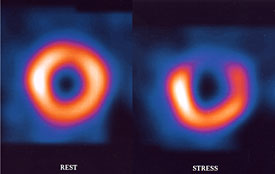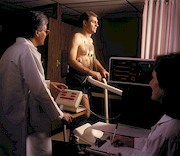 |
| Images taken at rest (left) and during exercise (right) from a nuclear stress test. |
|
A nuclear stress test lets doctors see pictures of your heart while you are resting and after you have exercised. The test can show the size of the heart's chambers, how well the heart is pumping blood, and whether the heart has any damaged or dead muscle. Nuclear stress tests can also give doctors information about your arteries and whether they might be narrowed or blocked because of coronary artery disease.
How does it work?
This test is almost the same as the exercise stress test, except doctors will give you a small amount of a radioactive substance just before the end of the exercise part of the test. This radioactive substance (such as thallium or sestamibi) is not harmful to your body or your organs.
The results of the nuclear stress test can show doctors if the heart is not working properly while you are resting, exercising, or both. If the test shows that blood flow is normal while you are resting but not normal while you are exercising, then doctors know that your blood flow to your heart is not adequate during times of stress. The heart normally pumps more blood during times of physical exertion. If the test results are not normal during both parts of the test (rest and exercise), part of your heart is permanently deprived of blood or is scarred. If doctors cannot see the radioactive substance in one part of your heart, it probably means that section of heart muscle has died, either because of a previous heart attack or because the coronary arteries supplying blood to that area of the heart are blocked.
What should I expect?
Just like the exercise stress test, you will have small metal disks called electrodes placed on your chest and back. The electrodes are attached to wires called leads, which are attached to an electrocardiogram machine. Doctors will then have you walk on a treadmill.
After your doctors have the information they need from the exercise part of the test, you will step off of the treadmill and go into another room. You will be given an injection of a radioactive substance, and you will be asked to lie on an examination table, which has a gamma-ray camera above it. The camera is used to take pictures of your heart. The camera can pick up traces of the radioactive substance in your body and then send a picture to a television monitor.
After this part of the test is over, you can leave the testing area for 3 or 4 hours. Doctors will ask you not to exercise or drink or eat anything with caffeine, such as coffee, tea, sodas, or chocolate. When you return, doctors will give you another injection of the radioactive substance. You will be asked to lie down on the examination table, and the gamma-ray camera will take pictures of your heart while you are resting. This will give your doctor an idea of how your heart works during both exercise and rest.
After the test is over, you may eat, drink, and go back to your normal activities right away.
See on other sites:
MedlinePlus
https://medlineplus.gov/ency/article/007201.htm
Nuclear stress test
Updated August 2016



